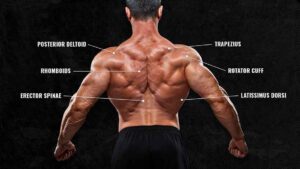Back Muscle Building Exercises
Training your back is essential for maintaining good posture, building strength, and preventing injuries, as it plays a key role in major movements like lifting, pulling, and stabilizing the spine, while also contributing to a well-developed, aesthetic V-taper physique that enhances overall athletic performance and functional fitness.
The key muscles of the back include the latissimus dorsi (lats), which create width and contribute to upper body strength; the trapezius (traps), which support posture and facilitate shoulder movements; the rhomboids, which aid in scapular retraction for better shoulder stability; and the erector spinae, which play a crucial role in spinal stability, posture maintenance, and lower back strength. These muscles work together to support movement, enhance overall back strength, and reduce the risk of injuries.

Back exercises enhance strength, mobility, and athletic performance while improving overall body balance and symmetry. They also help prevent common issues like lower back pain, promote better posture, reduce the risk of injuries, and support spinal health for long-term well-being.
2. Types of Back Exercises

Compound exercises, such as deadlifts and rows, engage multiple muscle groups simultaneously, promoting overall strength and coordination, while isolation exercises, like lat pulldowns and face pulls, specifically target individual muscles to enhance definition and address muscle imbalances.

Free weights (barbells, dumbbells) enhance muscle activation and range of motion, machines offer stability and are ideal for beginners, while bodyweight exercises (pull-ups, hyperextensions) improve functional strength, balance, and endurance, making all three essential for a well-rounded fitness routine.
3. Best Back Muscle Building Exercises
- Deadlifts

The deadlift is a powerful compound exercise that engages the entire posterior chain, including the lower back, lats, traps, and glutes, making it highly effective for building raw strength and power; it comes in several variations, such as Conventional, Romanian, Sumo, and Trap Bar Deadlifts, each offering unique benefits for different training goals.
- Pull-ups (Wide & Close Grip)

Pull-ups, whether assisted, bodyweight, or weighted, are an effective exercise that targets the lats, biceps, and traps, with a wide grip emphasizing lat width and a close grip enhancing overall back thickness, making them essential for building upper body strength and muscle definition.
- Barbell Rows (Overhand & Underhand)

This exercise engages the lats, traps, rhomboids, and lower back, with an overhand grip primarily targeting the upper back and an underhand grip emphasizing the lower lats for a well-rounded back workout.
- T-Bar Rows

This exercise, performed using a barbell or machine, effectively adds thickness to the middle back by targeting key muscle groups such as the rhomboids, traps, and erector spinae.
- Seated Cable Rows

The neutral grip facilitates controlled muscle engagement, specifically targeting the rhomboids and lats, to enhance mid-back development while promoting better posture and reducing strain on the shoulders.
- Lat Pulldown (Wide & Close Grip)

This exercise is great for beginners who can’t do pull-ups yet, offering a wide grip to target lat width and a close grip for focusing on the inner back, helping to build strength and form for more advanced movements over time.
- Face Pulls

Strengthening the rear delts, traps, and small stabilizer muscles not only improves posture but also helps prevent shoulder injuries by enhancing the stability and overall strength of the shoulder area.
- Dumbbell Pullovers

Enhancing lateral stretch and rib cage expansion, this exercise can also engage the chest, depending on the form and technique used, promoting greater flexibility and muscle activation throughout the upper body.
- Reverse Flys
This exercise targets the rear delts and rhomboids to improve back symmetry and can be performed using either dumbbells or cables, offering versatility for targeting these key muscle groups. Additionally, incorporating both methods can enhance muscle engagement and promote balanced development in the upper back.
- Hyperextensions (Back Extensions)
Strengthening the lower back and enhancing spinal stability not only supports better posture but also helps prevent injuries by improving the overall strength and flexibility of the muscles surrounding the spine.
Workout Routines for Different Goals
The Beginner Routine (Basic Strength & Endurance) focuses on building foundational strength and endurance with a structured workout: Deadlifts (3 sets of 6–8 reps) to develop overall posterior chain strength, Lat Pulldown (3 sets of 10–12 reps) for upper back and lat development, Seated Cable Rows (3 sets of 12 reps) to enhance mid-back muscles and posture, and Hyperextensions (3 sets of 15 reps) to strengthen the lower back and improve core stability.
For muscle growth and definition at an intermediate level, perform a back-focused routine consisting of 4 sets of 8 pull-ups, 4 sets of 8–10 barbell rows, 3 sets of 10 T-bar rows, 3 sets of 12 face pulls, and 3 sets of 12 dumbbell pullovers, ensuring controlled movements, proper form, and progressive overload for optimal results.
The Advanced Routine for Power & Size focuses on building strength and muscle mass through a structured workout, including 4-5 sets of 4-6 reps of Deadlifts for overall posterior chain development, 4 sets of 6-8 reps of Weighted Pull-ups to enhance upper body pulling strength, 4 sets of 8 reps of Barbell Rows for back thickness, 4 sets of 10 reps of T-Bar Rows to target mid-back muscles, and 3 sets of 12 reps of Reverse Flys to strengthen the rear delts and improve shoulder stability. This routine emphasizes progressive overload and proper form to maximize gains.
Common Mistakes & Injury Prevention
Poor form, such as rounding the back during deadlifts, using momentum instead of muscle engagement, neglecting the lower back and rear delts, and overtraining without adequate recovery, can lead to muscle imbalances, reduced workout effectiveness, fatigue, and an increased risk of injury, especially in the long term. Ensuring proper technique, balanced muscle activation, and incorporating sufficient rest are crucial to maximizing performance and preventing harm.
Tips for Maximum Gains
To build strength effectively, progressively increase weights while adhering to proper rep ranges—4-6 reps for strength, 8-12 reps for hypertrophy (muscle growth), and 12-15 reps for endurance—while also ensuring proper recovery and nutrition by consuming sufficient protein and calories for muscle repair, getting adequate sleep and rest to prevent overtraining, and maintaining a balanced routine that supports long-term growth and performance improvements.
Consistency is key when sticking to a structured workout plan, as tracking progress by gradually increasing weights or reps over time, focusing on form, and prioritizing recovery to avoid injuries will not only lead to a strong back but also improve posture, overall strength, and long-term fitness gains. Additionally, building a solid foundation through these practices enhances endurance, flexibility, and mental resilience, ensuring sustainable results and better overall health.
Read more about how to Best pre workout meal to lose weight




